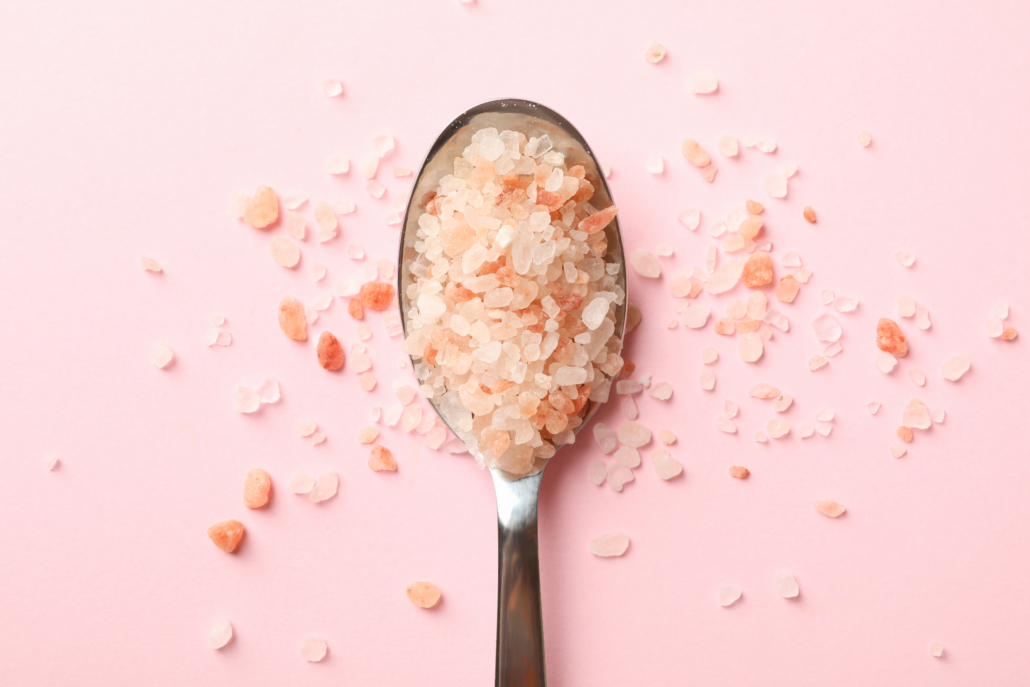We include products in articles we think are useful for our readers. If you buy products or services through links on our website, we may earn a small commission.
The Benefits of Pink Himalayan Salt

Himalayan salt has seen a sharp rise in popularity since the early 2000s, though its benefits have been prized by different cultures for centuries.
Mined from ancient sea beds at the base of the Himalayan mountains, this pink-hued rock salt is more than just an eye-catching flavor enhancer. It contains essential nutrients that balance and maintain our fluids, and cellular functions and support vital physiological functions such as conducting nerve impulses and muscle contraction. And because of its trace mineral composition, Himalayan salt has been associated with more potential health benefits than processed table salts.
In this article, we’ll take a closer at the benefits of Himalayan salt and how its unique mineral composition may add to our overall health and well-being.
Table of Contents
What is Himalayan Salt?
Himalayan salt is a type of unrefined rock salt that comes from the northern Punjab region of Pakistan. It is mined from ancient seabeds that were submerged by lava eruptions over 200 million years ago.
The pink hue of Himalayan salt is linked to its composition of trace minerals, specifically iron and magnesium.
While salt mining has taken place in this region since the era of Alexander the Great in 320 BC, production really ramped up during British rule in the late 1800’s. For hundreds of years, Pakistan exported its salt to India, the hub of an international market for this special salt. Today, Pakistan has full control of its salt production.
How is Himalayan Salt Produced?
Hailing from the Salt Range mountains in Pakistan, Himalayan salt is still extracted by hand to this day.
Most of the Himalayan salt you see available at your local market is sourced from the Khewra Salt Mine, one of the oldest and largest mines of its kind.

There are 17 levels to this mine, and it employs hundreds of people to extract the salt rocks using rudimentary tools like pickaxes, hand drills, and gunpowder. The mine produces around 1000 tons of salt per day, leaving a large portion underground and intact for structural support. This particular region is said to contain over 6.7 billion tons of salt.
Once the salt rocks have been extracted, they are minimally processed as opposed to standard table salt, which can be treated with bleach and anti-caking agents before reaching consumers.
However, some of these salt mines in the region are not suitable for food use without a purification process.
In addition to food flavoring, Himalayan salt is sold in the form of popular salt lamps, serving dishes, baking stones, and decorative statues.
Health Benefits of Himalayan Salt
The minerals in salt, specifically sodium and chloride, are “essential.” In nutritional jargon, “essential” has a very specific meaning–we need to get it in our diet in order to survive.
Himalayan salt is composed of around 98% sodium and chloride.
Proper salt intake in our daily diets is essential to
- Maintaining a balance of fluids within and around cells
- Maintaining a healthy blood pressure
- Supporting muscle contraction
- Supporting nerve impulses and signaling
Mineral Composition of Himalayan Salt
One of the main differences between Himalayan salt and other salts on the market is its higher composition of trace minerals such as iron, zinc, magnesium, and potassium. By some estimates, Himalayan salt contains as many as 84 trace minerals.
While Himalayan salt contains more trace minerals than table salt, some argue that it would require an intake of approximately >30 mg/day or 6 teaspoons/day to make any significant contribution to nutrition. This amount exceeds typical nutrition guidelines of 1-2 teaspoons of salt per day.
But if you’re on a low-carb diet regimen like keto or carnivore, you’ll likely need to be consuming far more salt than usual. In this case, the trace minerals in Himalayan salt can make a positive impact.
In the chart below, you can find a quantitative breakdown of the minerals typically found in Himalayan salt:
| Compounds | Quantity |
| Sodium | 38.26% |
| Chloride | 59.09% |
| Potassium | .35% |
| Calcium | 0.405% |
| Magnesium | 0.016% |
| Iron | 38.9 ppm |
| Zinc | 2.38 ppm |
| Copper | 0.56 ppm |
Why Trace Minerals in Himalayan Salt Matter
Salt is essential to the human body and is classified as an electrolyte. When ingested, the minerals in Himalayan salt dissolve in the body’s fluids and create electrically charged ions.
Electrolytes work together to accomplish a variety of different physiological tasks.
Sodium and Potassium :
- Maintain normal cellular homeostasis
- Maintain the correct balance of fluids in the body
- Conduct the electricity critical for nerve impulses and muscle contractions–including in the heart muscle.
Calcium :
- Lowers blood pressure and cholesterol
- Maintains bone health and prevents osteoporosis
- Involved in intracellular signaling and hormonal secretion
Iron :
- Supports gene regulation
- Maintains binding and transportation of oxygen
- Regulates cell growth and differentiation
Copper :
- Builds red blood cells, collagen, connective tissues, and neurotransmitters
- Aids in iron absorption
- Protects against free-radical damage to proteins and membrane lipids
Zinc :
- Antioxidant that reduces inflammation in the body
- Supports growth and repair of body tissues
- Supports mobilization of vitamin A and healthy eye function
Health Benefits of Himalayan Salt: The Bottom Line
Himalayan salt is a type of rock salt with vibrant pink hues that set it apart from other common salts. Mined from the depths of Pakistan’s Salt Range mountains, Himalayan pink salt comes from the dried remains of an ancient seabed dating back more than 200 million years.
Unlike table salt, Himalayan salt contains a wide range of trace minerals that are kept intact during its hand extraction and minimal processing.
These trace minerals and nutrients play essential roles in several vital physiological functions, such as maintaining normal cellular homeostasis, balance of bodily fluids, and the conduction of nerve impulses and muscle contractions.
Not only does Himalayan salt add flavor to our favorite rib-eye steak, but Himalayan salt can help our nutrient absorption and maintain our overall sense of balance and wellness.




















